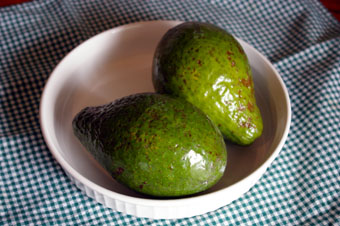
The Lovely Avocado
| published November 5, 2015 |
By Lisa K. Whitten
Thursday Review writer/web developer
What is an avocado? If you guessed "fruit" you are right, but did you know that it is also a berry? A single-seeded berry, at that. The avocado has a subtle taste, a little on the nutty side, but oh so good and good for you!
Avocados are touted as a super food. They are loaded with vitamins—up to 20—and minerals. They help control blood pressure, have been shown in some medical studies to reduce the risk of some forms of cancer, and they are helpful for your eyes. They are low in sugar, but high in calories. A fifth of an avocado is 50 calories. The fiber in an avocado, however, makes you feel fuller longer so less is enough—which is the advantage of avocados if you are looking for ways to lose weight.
One of the most frequently-asked questions about the avocado: How do you know when an avocado is ripe? When purchasing an avocado the skin is not the best way to determine its ripeness. The best way is to palm it and apply slight pressure. If it is ripe it will give a little. If it gives too much it may be overripe and will be mushy. If it doesn't give at all it needs more time to ripen.

To prepare the avocado, slice it vertically all the way around. Pull the two sides gently apart. Then pull the pit out. You may need to rock it gently, or in case of a stubborn pit you may need to slide the knife carefully around the edges. Once the pit has been removed you can then remove the peel. You should be able to peel it by grasping the edge at the top of the avocado and gently pulling it off. If it does not come off easily—which sometimes happens—you may need to use a knife to take the peel off.
What do you do with an avocado once it is pitted and peeled? The avocado can be thinly sliced and added to a sandwich, and replacing the less healthy option of mayonnaise. Avocado can also be sliced or chopped and added to a salad. Its understated flavor means it rarely clashes with other salad ingredients, and it adds a different shade of color to a green salad. Avocados can also be mashed, and after adding a few other ingredients and seasonings, it can be used to create a healthy guacamole dip for your veggies—like celery, peppers, carrots, broccoli and cauliflower.
To store your leftover avocado simply put a little lemon juice on it to help preserve the freshness and color. Wrap it in clear plastic, putting the covering directly on the avocado. This will keep it fresh for a couple of days.
If you haven't tried the avocado try the guacamole recipe below. You might be pleasantly surprised. Have an avocado recipe you would like to share? Send it to Thursday Review and we will feature it in a future article (see below, under the recipe).
GUACAMOLE
- 2 large ripe avocados
- 2-3 Tablespoons lemon or lime juice
- Salt (optional)
- 1-2 Tablespoons chopped fresh cilantro
or 1/2 teaspoon ground coriander (optional) - 2-4 canned green chiles (rinsed, seeded, and chopped)
and/or cayenne, liquid hot pepper seasoning, or minced hot green chiles to taste
Instructions:
Cut avocados in half, remove pits, and peel. Mash coarsely with a fork blending in lemon or lime juice. Add salt to taste and cilantro if desired. Add optional chiles, cayenne, hot pepper seasoning. Serve with raw vegetables for dipping. Optional additions: Add 1 clove of garlic (minced or pressed) or 2-3 Tablespoons minced onion. Add 1 large tomato - peeled, seeded and chopped.
Send us your avocado recipe! Send to: ThursdayReview@thursdayreview.com. If we print here, on the Thursday Review website, you could receive a free Thursday Review coffee/tea mug, which we will mail anywhere in the United States or Canada.
